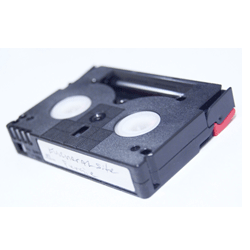| Storage Media | Hard Disks | DVD Disc | |||
| Optical Discs | Tape Media | Flash Drive | |||
| Zip Catridges | RAID | Removable Media | |||
| (U)niversal (B)us (S)erial |
What is a Tape Media?
 |
A tape drive is a peripheral hardware device that reads and writes data into non-volatile magnetic tapes. A magnetic tape that resembles a conventional audio cassette tape, contains a magnetized coating on a thin plastic strip which data is written on.
Unlike dynamic and random storage mediums such as hard disks and flash drives, a tape drive operates using indexing and sequential-access. You have to run a tape from beginning to the end to perform a read or write operation. This means that data is written to the tape in one continuous stream.
To read a particular piece of information, the tape must wind past all preceding data to access it. Quite simply, a tape drive is like a cassette recorder that stores large volumes of digital data. Due to its cost efficiency and long shell life, tape drive makes a popular device for backup and archival purposes.
How Does it Work?
A tape drive uses a controlled motor to wind the tape from one reel to another with its magnetic strip passing a read/write head.
To cope with the difference between the rate which data is written into the tape and the data streaming to or from the computer or host, the tape drives incorporates a tape drive controller, which performs buffer procedures and logical operations such as ECC (Error Correction Code) during the data storage process.
During a backup process, the computer memory buffer is loaded with the data information from the host computer and sent to the controller's buffer. The controller then commands the recording mechanism to write the data into tape. When it completes, more data is loaded into the controller buffer from the computer and the cycle repeats itself until all data has been completely stored.
Storage capacity of tape drives range from a few hundred megabytes to several Terabytes compressed. They support compression capability and transfer rate of over 500MB/s. Tape drives are interoperable and usually connected to the computer via SCSI, IDE, USB and Firewire.
Tape Drive comes in several formats or standards:
AIT (Advanced Intelligent Tape) |
AIT is 8mm across and uses helical scanning technique and the MIC (Memory In Cassette) technology to provide increased access. It also supports high data transfer rate up to 78 MB/sec and maximum storage capacity of 500GB compressed using ALDC (adaptive lossless data compression) technologies. |
DAT (Digital Audio Tape) |
DAT is 4mm across and offers over 40GB of storage at a data transfer speed of about 5 Mb per second and is optimized for high volume backups. |
DLT (Digital Linear Tape) |
DLT uses a technique to write data onto the tape in 128 or 208 linear tracks. DLT cartridges can contain around 70GB of data with compression. SuperDLT, a new DLT variant supports tape capacity up to 300GB(SDLT 600) and transfer data at speeds up to 36MB/sec. |
LTO (Linear Tape-Open) |
LTO uses an open-format technology that provides compatibility to various storage media products. It supports a capacity up to 6.4 Terabytes and transfer rate of 540MB/s. |
Packet Tape |
Packet Tape - available from VXA (tape manufacturer) has a capacity of 33GB native and 66GB compressed. It is an 8mm format and one that is commonly used by home-based business owners. |

